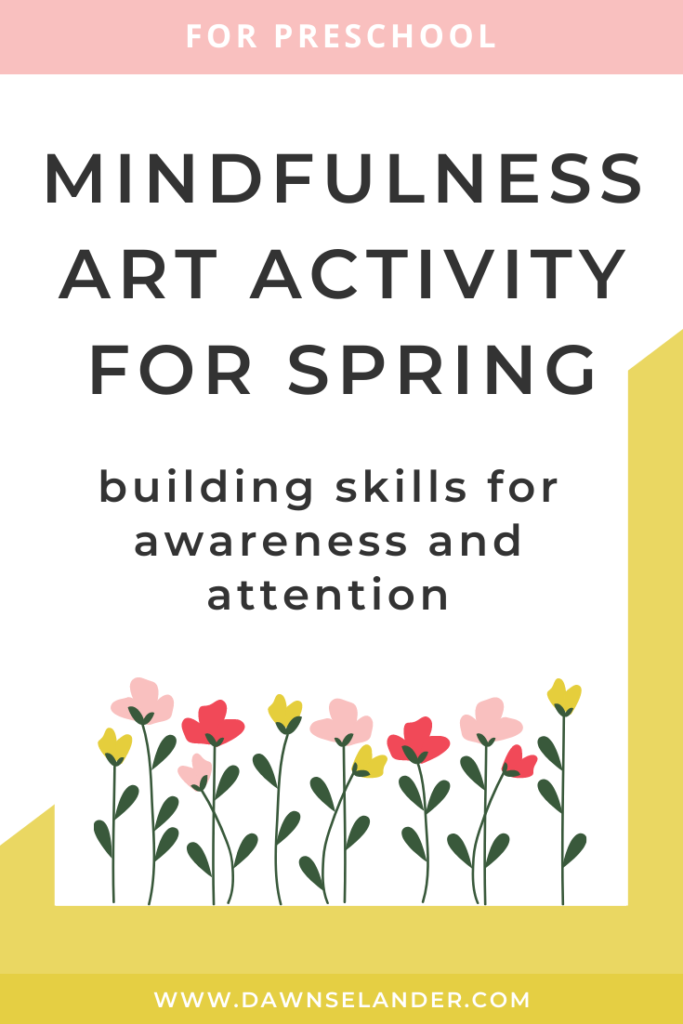
As an Amazon Associate, I earn from qualifying purchases.
mindfulness art activity for spring
If you're preparing lesson plans for the new season, then you'll want to add this mindfulness art activity for Spring. This "focus and notice" mindfulness activity is the perfect practice for building attention and awareness skills.
Noticing details helps us enjoy and explore the little treasures and wonders that are part of the bigger picture that might otherwise get missed, whether in the art pieces of this activity or in life.
As we continue to practice "focus and notice", we can apply it to ourselves. We can use the skill to notice what is happening in our body, notice the types of thoughts passing through our mind, and notice our emotions as they come and go throughout the day.
This way, when our body, our thoughts, or our emotions don't feel good to us, we are aware because we have practiced "focus and notice". Then, with awareness we have the choice to keep going with what isn't working for us or make a change.
mindfulness art activity
This activity combines mindfulness and art with a Spring theme that's perfect to add into your lesson plans all season long.
You'll need copies of Spring-themed famous paintings and some magnifying glasses (fun to use but not necessary) for this "focus and notice" mindfulness activity. Print some artwork from your computer (legally) or grab an art book from the library.
You can give each child a copy of the same art piece or mix it up with a few different ones. Make it exciting and let them know they are going to be "art detectives" or they are going on a hunt to find treasures in the art that everyone else misses because they may not take the time to notice the details.
Here's what you do:
- Give each child a magnifying glass and a copy of a Spring-themed art piece
- Next, have them sit up tall and take a deep breath to settle in
- Then, take another deep breath if they feel they need to
- Explain this is a quiet activity so they can fully enjoy the art without distractions
- Allow them a few minutes to explore the picture with their eyes to "focus and notice" what they can about the "big picture"
- Have them close their eyes and take a another deep breath
- Let them explore the painting again and ask them to find three things they didn't notice the first time
- After a few minutes have them close their eyes and take another deep breath
- Have them explore the painting with the magnifying glass and find three more things they hadn't noticed before
As they explore deeper and deeper into the smallest details of the painting, a whole new experience opens up. Maybe they will find a brushstroke or a line or a dot they hadn't noticed in the big picture, making their experience richer and the artwork more meaningful.
related: Three simple steps to deep breathing
HAve a discussion
Allow your preschoolers time to share their findings when the activity is over. Here are some questions to start your discussion:
- can you describe the big picture as if you were explaining it to an alien from outer space who had never seen it
- what was the first thing you noticed about the artwork
- did you get a feeling inside when you first saw the art
- how do you know the painting is about spring, what are your clues (flowers, objects, colors, overall feeling)
- were you able to notice smaller details with your eyes when you focused in, what were they (shades of colors, lines, a small object, etc)
- how about when you used the magnifying glass, what did you notice then
- were you surprised at how much more you noticed when you looked closely
- what feelings did you get inside after noticing the smallest details in the work, did the feeling change from before
- can you think of other times when you would want to notice the small details
You can repeat this activity over and over so that your preschoolers search for different clues each time. Your kiddos can search for:
- clues for Spring
- how many different colors of green they can find
- different kinds of flowers
This list can go on and on, I think you get the point. Just rinse and repeat as long as your kiddos are engaged and having fun with it.
Related: focus and notice activity for your pumpkin theme
Spring-themed art pieces
Here are some paintings you might consider using for this mindfulness art activity for Spring.
- Almond Blossom, Vincent van Gogh
- Springtime, Claude Monet
- Spring, Rene Magritte
- Spring, Lawrence Alma-Tadema
- Spring In Town, Grant Wood
- Spring Margot Standing In A Garden, Mary Cassatt
And, there are soooo many more Spring related paintings. Choose a variety of subjects and styles to compare.
Doing double duty
This Springtime mindfulness activity can do double duty in your preschool classroom.
- Use the pieces for an art lesson- teach about the author and the history/meanings of the art
- Add in some observation skills- observe and compare subject matter/colors/style/feeling within single pieces of art and between two or more pieces
- Laminate some copies for your centers- add some laminated pieces to your art center or peace center
- Dramatic play ideas- use your dramatic play area as a frame shop, art store, or art gallery
Don't try to do it all in one day. Spread the activities out over your Spring-themed week or revisit these activities all Spring long. Use the same artwork to dive deeper and deeper into it and other times add in some fresh new pieces.
related: how to create an outdoor peace center
focus within
Focus and notice skills are important for making experiences more meaningful as you saw with the artwork. But, it's also important to focus and notice things about ourselves.
When things don't feel good or aren't working for us, it's much easier (and better for everyone) to notice it and make a change before we get stressed out, sick, or explode with emotion.
Practice these skills so you can remind your kiddos to notice what is going on within while they are in a difficult moment. If they are completely wrapped up in emotion, you might want to skip it, but if not, you can ask them to notice what they feel and where they feel it in their body. How strong is the sensation? Is it a physical feeling? Do they notice an emotion inside? What are their thoughts?
Once we notice it, we can chose what to do with it- keep moving forward with it or make an adjustment and change for the better :).
related: Progressive muscle relaxation
Laughing Meditation
If you're looking for more mindfulness activities to add to your preschool day, check out The Mindfulness Library for free, 24/7 access to meditation scripts, activity packets, deep breathing printables and more.
Do you like to teach art? I can't wait to see the creative ways you use mindfulness in art. Let me know below.
~ Dawn

